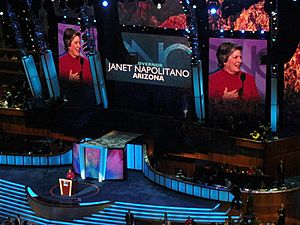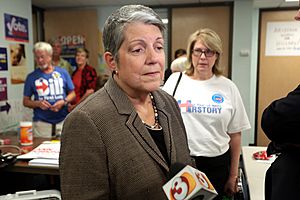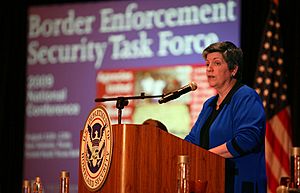Janet Napolitano facts for kids
Quick facts for kids
Janet Napolitano
|
|
|---|---|

Napolitano in 2024
|
|
| 20th President of the University of California | |
| In office September 30, 2013 – August 1, 2020 |
|
| Preceded by | Mark Yudof |
| Succeeded by | Michael V. Drake |
| 3rd United States Secretary of Homeland Security | |
| In office January 21, 2009 – September 6, 2013 |
|
| President | Barack Obama |
| Deputy | Jane Holl Lute Rand Beers (acting) |
| Preceded by | Michael Chertoff |
| Succeeded by | Jeh Johnson |
| 21st Governor of Arizona | |
| In office January 6, 2003 – January 21, 2009 |
|
| Preceded by | Jane Dee Hull |
| Succeeded by | Jan Brewer |
| 23rd Attorney General of Arizona | |
| In office January 4, 1999 – January 6, 2003 |
|
| Governor | Jane Dee Hull |
| Preceded by | Grant Woods |
| Succeeded by | Terry Goddard |
| United States Attorney for the District of Arizona | |
| In office November 19, 1993 – November 1, 1997 |
|
| President | Bill Clinton |
| Preceded by | Linda Akers |
| Succeeded by | Jose de Jesus Rivera |
| Personal details | |
| Born |
Janet Ann Napolitano
November 29, 1957 New York City, U.S. |
| Political party | Democratic |
| Education | Santa Clara University (BS) University of Virginia (JD) |
| Signature |  |
Janet Ann Napolitano (born November 29, 1957) is an American politician, lawyer, and academic leader. She has held many important roles in government and education. From 2013 to 2020, she was the president of the University of California. Before that, she served as the United States Secretary of Homeland Security from 2009 to 2013 under President Barack Obama. She was also the 21st governor of Arizona from 2003 to 2009.
Janet Napolitano was the first woman to hold several of these high-level positions. These include being the attorney general of Arizona, the secretary of homeland security, and the president of the University of California.
Forbes magazine recognized her as one of the world's most powerful women in 2012 and 2013. She was also considered a possible future candidate for president of the United States.
Contents
Early Life and Education
Janet Napolitano was born in New York City on November 29, 1957. Her father, Leonard Michael Napolitano, was a dean at a medical school. Her family moved around, and she grew up in Pittsburgh, Pennsylvania, and Albuquerque, New Mexico. She finished high school in Albuquerque in 1975.
She went to Santa Clara University, earning a Bachelor of Science degree in political science in 1979. She then studied law at the University of Virginia and received her law degree in 1983.
Janet Napolitano was the first female valedictorian at Santa Clara University. After law school, she worked as a law clerk for a judge. Later, she joined a law firm in Phoenix, Arizona, and became a partner there in 1989.
Career Highlights
In 1993, President Bill Clinton chose Janet Napolitano to be the United States Attorney for Arizona. In this role, she was a top lawyer for the federal government in her state. She was involved in the investigation related to the Oklahoma City bombing.
In 1998, she was elected as the Arizona Attorney General. This meant she was the chief legal officer for the state of Arizona. During her time as attorney general, she focused on protecting consumers and improving law enforcement.
Governor of Arizona

In 2002, Janet Napolitano won the election to become the governor of Arizona. She was the third woman to be governor of Arizona and the first woman to be elected governor after another woman governor. She was also the first Democrat to be popularly elected governor in Arizona since 1987.
She was re-elected as governor in 2006, winning by a large margin. She was the first woman to be re-elected to that office in Arizona. As governor, she set a record for the number of times she used her veto power to stop bills from becoming law.
As governor, Napolitano supported many education programs. She helped create voluntary full-day kindergarten in Arizona. She also started a program to improve reading skills and worked to increase teacher salaries. She made big investments in higher education, including funding a new medical school campus in Phoenix.
She also helped the state save money in its "rainy day fund" for emergencies. She played a key role in bringing Super Bowl XLII to Arizona and invested in tourism. She was one of the first governors to ask for the National Guard to help with border security.
Secretary of Homeland Security
In December 2008, President-elect Barack Obama chose Janet Napolitano to be the United States Secretary of Homeland Security. She was confirmed in January 2009, becoming the first woman to lead this department. The Department of Homeland Security works to protect the United States from threats.
As Secretary, Napolitano was a key leader in the government's response to the 2009 flu pandemic. She focused on educating people about prevention rather than closing schools and businesses. This helped reduce the expected impact of the flu.
After an attempted terrorist attack on a flight in December 2009, Napolitano introduced new security measures at airports. These included enhanced pat-down screenings and the use of full body scanners.
To make airport security faster, she created TSA PreCheck. This program allows travelers to provide background information to the Transportation Security Administration (TSA) for quicker security checks. She also expanded the Global Entry program, which helps trusted travelers get through customs faster.
Under her leadership, the Department of Homeland Security invested a lot in border security technology along the southern border with Mexico.

Napolitano was a strong supporter of immigration reform. In 2012, she helped create the Deferred Action for Childhood Arrivals (DACA) program. This program allowed young people, known as DREAMers, who were brought to the U.S. as children, to stay in the country without fear of deportation.
President of the University of California
In July 2013, Janet Napolitano announced she would leave her role as Secretary of Homeland Security to become the president of the University of California (UC). She was appointed the 20th president on July 18, 2013, becoming the first woman to lead the University of California system. She started her new role on September 30, 2013. She announced her resignation from this position in September 2019, and her term ended on August 1, 2020.
As UC president, she increased support for undocumented students and worked to make the university's graduate programs more diverse. She also started a plan for the ten-campus system to become carbon neutral by 2025, meaning it would have no net release of carbon dioxide into the atmosphere.
Napolitano also encouraged students to pursue careers that serve the public. She created programs to help law students who want to work in public interest law. She also launched the Global Food Initiative in 2014, which aimed to help University of California students get access to healthy food.
In 2017, the University of California established the National Center for Free Speech and Civic Engagement, which Napolitano chaired. This center focuses on research and education about free speech.

During her time as UC president, undergraduate tuition remained stable, with only one small increase in 2017.
University of California Challenges
In April 2017, a report from the California State Auditor raised concerns about the University of California Office of the President's budget practices under Janet Napolitano. An independent report later found that Napolitano had approved a plan that encouraged UC campuses to change their survey responses about her administration.
In September 2017, the University of California and Janet Napolitano filed a lawsuit against the U.S. Federal Government. This lawsuit challenged the decision to end the DACA program, which Napolitano had helped create.
In 2020, some graduate students at University of California, Santa Cruz went on strike for better living wages. Napolitano dismissed 82 of these students for withholding grades.
Later Career
After leaving the University of California, Janet Napolitano continued to be a faculty member at the Goldman School of Public Policy at UC Berkeley. In 2021, she founded and became the director of the Center for Security in Politics.
In May 2022, she was appointed to the President's Intelligence Advisory Board. This board advises the President on intelligence matters.
Personal Life
Janet Napolitano enjoys sports and outdoor activities. She is a basketball fan and plays tennis and softball. Her hobbies include whitewater rafting and hiking. She has hiked in various mountains and climbed Mount Kilimanjaro.
She has never married and does not have children. She has described herself as a "straight, single workaholic".
In August 2016, Napolitano began receiving treatment for cancer. She was hospitalized for complications in January 2017 but was released a few days later.
See also
 In Spanish: Janet Napolitano para niños
In Spanish: Janet Napolitano para niños
- List of female United States Cabinet members
- List of female state attorneys general in the United States
- List of female governors in the United States




